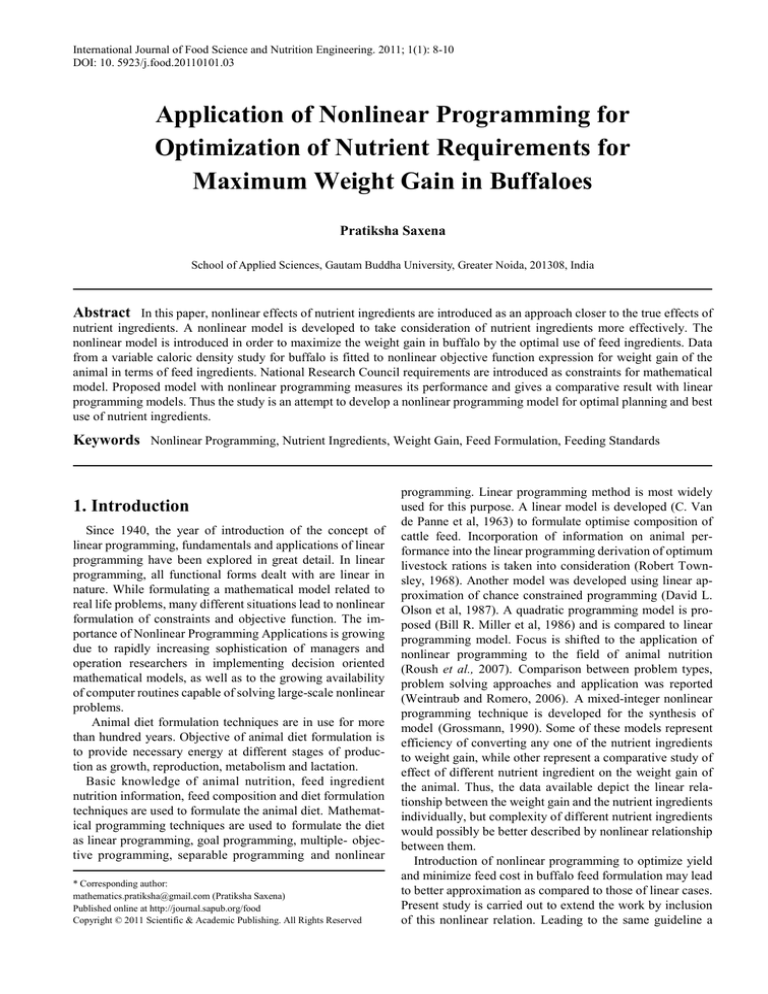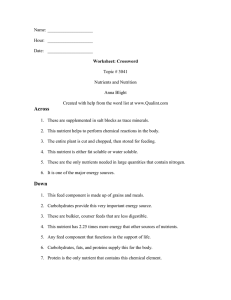
International Journal of Food Science and Nutrition Engineering. 2011; 1(1): 8-10
DOI: 10. 5923/j.food.20110101.03
Application of Nonlinear Programming for
Optimization of Nutrient Requirements for
Maximum Weight Gain in Buffaloes
Pratiksha Saxena
School of Applied Sciences, Gautam Buddha University, Greater Noida, 201308, India
Abstract In this paper, nonlinear effects of nutrient ingredients are introduced as an approach closer to the true effects of
nutrient ingredients. A nonlinear model is developed to take consideration of nutrient ingredients more effectively. The
nonlinear model is introduced in order to maximize the weight gain in buffalo by the optimal use of feed ingredients. Data
from a variable caloric density study for buffalo is fitted to nonlinear objective function expression for weight gain of the
animal in terms of feed ingredients. National Research Council requirements are introduced as constraints for mathematical
model. Proposed model with nonlinear programming measures its performance and gives a comparative result with linear
programming models. Thus the study is an attempt to develop a nonlinear programming model for optimal planning and best
use of nutrient ingredients.
Keywords Nonlinear Programming, Nutrient Ingredients, Weight Gain, Feed Formulation, Feeding Standards
1. Introduction
Since 1940, the year of introduction of the concept of
linear programming, fundamentals and applications of linear
programming have been explored in great detail. In linear
programming, all functional forms dealt with are linear in
nature. While formulating a mathematical model related to
real life problems, many different situations lead to nonlinear
formulation of constraints and objective function. The importance of Nonlinear Programming Applications is growing
due to rapidly increasing sophistication of managers and
operation researchers in implementing decision oriented
mathematical models, as well as to the growing availability
of computer routines capable of solving large-scale nonlinear
problems.
Animal diet formulation techniques are in use for more
than hundred years. Objective of animal diet formulation is
to provide necessary energy at different stages of production as growth, reproduction, metabolism and lactation.
Basic knowledge of animal nutrition, feed ingredient
nutrition information, feed composition and diet formulation
techniques are used to formulate the animal diet. Mathematical programming techniques are used to formulate the diet
as linear programming, goal programming, multiple- objective programming, separable programming and nonlinear
* Corresponding author:
mathematics.pratiksha@gmail.com (Pratiksha Saxena)
Published online at http://journal.sapub.org/food
Copyright © 2011 Scientific & Academic Publishing. All Rights Reserved
programming. Linear programming method is most widely
used for this purpose. A linear model is developed (C. Van
de Panne et al, 1963) to formulate optimise composition of
cattle feed. Incorporation of information on animal performance into the linear programming derivation of optimum
livestock rations is taken into consideration (Robert Townsley, 1968). Another model was developed using linear approximation of chance constrained programming (David L.
Olson et al, 1987). A quadratic programming model is proposed (Bill R. Miller et al, 1986) and is compared to linear
programming model. Focus is shifted to the application of
nonlinear programming to the field of animal nutrition
(Roush et al., 2007). Comparison between problem types,
problem solving approaches and application was reported
(Weintraub and Romero, 2006). A mixed-integer nonlinear
programming technique is developed for the synthesis of
model (Grossmann, 1990). Some of these models represent
efficiency of converting any one of the nutrient ingredients
to weight gain, while other represent a comparative study of
effect of different nutrient ingredient on the weight gain of
the animal. Thus, the data available depict the linear relationship between the weight gain and the nutrient ingredients
individually, but complexity of different nutrient ingredients
would possibly be better described by nonlinear relationship
between them.
Introduction of nonlinear programming to optimize yield
and minimize feed cost in buffalo feed formulation may lead
to better approximation as compared to those of linear cases.
Present study is carried out to extend the work by inclusion
of this nonlinear relation. Leading to the same guideline a
International Journal of Food Science and Nutrition Engineering. 2011; 1(1): 8-11
ration can be formulated using all its nutrient ingredients
simultaneously at the optimum level. In this paper, it is envisaged to develop a mathematical model using non-linear
programming to take simultaneous effects of all nutrient
ingredients and the diet is optimized by using Kuhn- Tucker
conditions. This result is also compared to than that of linear
programming formulation of the model.
9
pendent variables is formulated to decide the weightage of
the variables. Assuming a linear relationship between weight
gain of buffaloes and intake of DM, CP and TDN, the
weightage of these variables was decided.
Using least square method, the relationship is depicted in
the following equation which describes the weightage of the
variables x1, x2 and x3.
y= 2.00542 × 10 x + 3.648748 × x
−1
1
2. Material and Methods
The present study is based on the secondary data of animal
experiment of Elangovan (1990). Briefly, the study consists
of male buffalo calves of about 6-9 months of age, which
were procured locally at Bareilly. Animals were dewormed
and vaccinated against common contagious diseases. The
animals were kept in a shed having cemented floor with
individual feeding arrangement during the feeding trial but
transferred to metabolic cages during metabolism trial.
Drinking water was provided to all calves ad libitum. Three
different feed treatments used in the experiment are given to
animal which are shown in Table 1.
Table 1. Dietary treatment given to animals
Feed
Block I
Block II
Deoiled rice bran
Wheat bhoosa
Control Group
I
------1.5 kg
ad lib
Experimental Group
II
III
500 gm
---------1.5 kg
1.5 kg
ad lib
ad lib
The animals were kept under these feeding regimens for
166 days. The calves were first fed on a standard farm ration
for about two months period to make them healthier in order
to avoid experimental error. The calves were offered feed,
once in a day between 8.30 to 9.00 AM. Ad libitum drinking
water was provided to all the calves twice a day. Animals
were weighed on two consecutive days at fortnightly intervals before feeding and watering. The study parameters
included digestibility of different nutrients as well as balances of nitrogen, calcium and phosphorus besides serum
urea.
The present study is carried out to maximize the weight
gain of the animal. The weight gain and the efficiency with
which the nutrients are utilized mainly depend on several
factors related to nutrient utilization (Maynard and Loosli,
1956), however weight gain of an animal mainly depends
upon digestible crude protein (DCP), total digestible nutrient
(TDN) and digestible dry matter (DM). Metabolic body
weight is used as a base for all the calculations (Elliot and
Toops, 1964). Input data for this work is represented in terms
of three nutrient ingredients DCP, TDN and DM.
3. Result and Discussion
3.1. Weightage of Variables
First of all, linear relationship for dependent and inde-
2
−7.691844 × 10 x + 2.671533
−2
(1)
3
3.2. Relationship between Variables
By using least square method, the relations between y and
x1, y and x2, y and x3 of different degrees were established
and then by using F-test the relation of best fit was decided.
Applying the F-test, the following most appropriate relationship between the variables were derived:
2
y = −3.454281× 10 2 + 2.174892 x1 − 2.851922 × 10 −3 x1
y = 3.251281 × 101 + 7.010015 × 10 −1 x 2
1
(2)
−1
y = −1.954685 × 10 + 2.424427 × 10 x3
3.3. Formulation of Objective Function
The objective function was established by using the appropriate relations of the variables x1, x2, x3 according to
their weightage on weight gain of the buffalo calves. The
weightage with respect to total effect of this weightage was
considered:
−17.77778869 + 0.131615729 x1
Y =
+0.077184052 x2 + 5.627355208 × 10 −3 x3 (3)
−1.7258688661× 10 −4 x12
3.4. Constraints
The constraints according to feeding standards on the
above-mentioned variables according to feeding standards of
NRC (1981) were applied
56.9 ≤ x1 ≤ 396.311
7.6816 ≤ x2 ≤ 37.708
220.4792 ≤ x3 ≤ 368.1687036
(4)
3.5. Problem Defined
The main problem is formulated to maximise weight gain
of the animal:
Y=
−17.77778869 + 0.131615729 x1 + 0.077184052 x2
+5.627355208 × 10−3 x3 − 1.725868661 × 10−4 x12
subject to:
56.9 ≤ x1 ≤ 396.311
7.6816 ≤ x2 ≤ 37.708
(5)
220.4792 ≤ x3 ≤ 368.1687036
3.6. Solution of the Problem
Introducing Kuhn-Tucker conditions, the weight gain of
the buffalo calves could be maximized as:
10
Pratiksha Saxena: Application of Nonlinear Programming for Optimization of
Nutrient Requirements for Maximum Weight Gain in Buffaloes
L=
−17.77778869 + 0.131615729 x1 + 0.077184052 x2
+5.627355208 × 10−3 x3 − 1.725868661 × 10−4 x12
−λ1 ( x1 − 396.311) − λ2 ( x2 − 37.708) − λ3 ( x3 − 368.1687036)
Using Kuhn-Tucker conditions, the following set of
equations were obtained for optimal solutions:
1. 0.70752862 − 1.855555531 × 10 −3 x1 − λ1 = 0
2. 0.393301399 − λ 2 = 0
3. 0.027548012 − λ3 = 0
4. λ1 (x1 − 396.311) = 0
5. λ 2 (x 2 − 37.708) = 0
6. λ3 ( x3 − 368.168706 ) = 0
7. x1 ≤ 396.311
8. x2 ≤ 37.708
9. x3 ≤ 368.1687036
10. λ1 , λ2 , λ3 ≥ 0
Solving these equations the optimum values of the three
nutrients is found out to maximize the body weight gain.
Accordingly we have:
x1 = 381.3028, x2 = 7.708, x3 = 368.1687036 g/kg W0.75
It also gives, λ1 = 0.393301399, λ2 = 0.027548012 which
satisfied all the conditions.
The problem is also formulized and solved by simplex
method and it gives,
x1 = 396.311, x2 = 37.708, x3 = 368.1687036 g/kg W0.75
Comparison shows that by linear programming result is
obtained at corner points of feasible area and optimization is
at comparatively at higher values of nutrient ingredients.
This comparison represents that non-linear programming is
better way to take simultaneous effect of all nutrient ingredients together and maximize the weight gain in animal with
optimized value of nutrient ingredients.
4. Conclusions
Comparison of the present nonlinear method with linear
programming represents that nonlinear programming gives
maximum weight gain with optimum use of nutrients. The
effect of these nutrients on body weight gain was considered and individual relations as obtained in equations
present the linear and nonlinear effects of different ingredient on body weight gain.
REFERENCES
[1]
C. Van de Panne, W. Popp. “Minimum-Cost Cattle Feed Under Probabilistic Protein Constarints”. Management Science.
Vol. 9, Issue 3, pp. 405-430, 1963
[2]
Robert Townsley (1968). Derivation of optimal livestock
rations using quadratic programming. Journal of Agricultural
Economics. 19(3): 347–354
[3]
David L. Olson and Scott R. Swenseth (1987).A Linear Approximation for Chance-Constrained Programming. J Operational Research Society. 38(3): 261-267
[4]
Bill R. Miller, Ronaldo A. Arraes, Gene M. Pesti (1986).
Formulation of Broiler Rations by Quadratic Programming.
Southern J Agricultural Economics. 141-151
[5]
Roush, W. B., Purswell J. and Branton, S. L. “Adjustable
nutrient margin of safety comparison using linear and stochastic programming in an Excel spreadsheet”, Journal of
Applied Poultry Research, Vol. 16, pp. 514-520, 2007
[6]
Weintraub, A. and Romeo, Operations research models and
the management of agricultural and forestry resources: A review and comparison”. Interfaces, Vol. 36, pp. 446-457, 2006
[7]
Grossmann, I. E. “J. Breckling, Ed. “Mixed-integer nonlinear
programming techniques for the synthesis of engineering
systems” Research in Engineering Design, Vol.1, pp. 205-228,
1990
[8]
Elangovan, A.V. “Nutrient Utilization and Growth Performance in Buffalo Calves Fed on Wheat Bhoosa and Oil Extracted Rice Bran Supplemented with Urea-molasses Cake”.
MVSc Thesis, Indian Veterinary Research Institute, Izzatnagar, India, 1990
[9]
Elliot, R. C. and Toops. “Studies of Protein requirements of
ruminants”. British Journal of Nutrition, Vol. 18, pp. 245-249,
1964
[10] Maynard L. A. and Loosli, J. K. Animal Nutrition, Tata
McGraw Hill, pp. 138-145, 1956.
[11] NRC, Report of Commission on Natural Resources, National
Research Council, National Academy Press, Washington, DC,
1981






